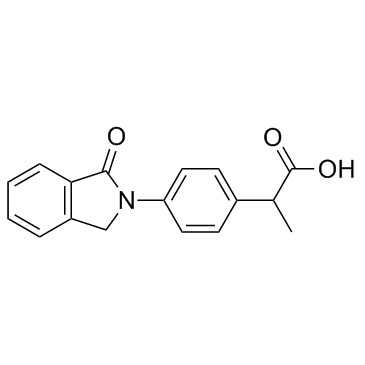Indoprofen upregulates the survival motor neuron protein through a cyclooxygenase-independent mechanism.
Mitchell R Lunn, David E Root, Allison M Martino, Stephen P Flaherty, Brian P Kelley, Daniel D Coovert, Arthur H Burghes, Nguyen Thi Man, Glenn E Morris, Jianhua Zhou, Elliot J Androphy, Charlotte J Sumner, Brent R Stockwell
Index: Chem. Biol. 11(11) , 1489-93, (2004)
Full Text: HTML
Abstract
Most patients with the pediatric neurodegenerative disease spinal muscular atrophy have a homozygous deletion of the survival motor neuron 1 (SMN1) gene, but retain one or more copies of the closely related SMN2 gene. The SMN2 gene encodes the same protein (SMN) but produces it at a low efficiency compared with the SMN1 gene. We performed a high-throughput screen of approximately 47,000 compounds to identify those that increase production of an SMN2-luciferase reporter protein, but not an SMN1-luciferase reporter protein. Indoprofen, a nonsteroidal anti-inflammatory drug (NSAID) and cyclooxygenase (COX) inhibitor, selectively increased SMN2-luciferase reporter protein and endogenous SMN protein and caused a 5-fold increase in the number of nuclear gems in fibroblasts from SMA patients. No other NSAIDs or COX inhibitors tested exhibited this activity.
Related Compounds
| Structure | Name/CAS No. | Molecular Formula | Articles |
|---|---|---|---|
 |
Indoprofen
CAS:31842-01-0 |
C17H15NO3 |
|
Evaluation of amino acid ester-based ionic liquids as buffer...
2014-09-01 [Electrophoresis 35(18) , 2573-8, (2014)] |
|
A chiral separation strategy for acidic drugs in capillary e...
2014-10-01 [Electrophoresis 35(19) , 2807-18, (2014)] |
|
Enantiomers separation by nano-liquid chromatography: use of...
2015-02-13 [J. Chromatogr. A. 1381 , 149-59, (2015)] |
|
Species-dependent binding of tocainide analogues to albumin:...
2014-10-01 [J. Chromatogr. B. Analyt. Technol. Biomed. Life Sci. 968 , 69-78, (2014)] |
|
Flavonoids from each of the six structural groups reactivate...
2014-10-01 [Carcinogenesis 35(10) , 2183-93, (2014)] |